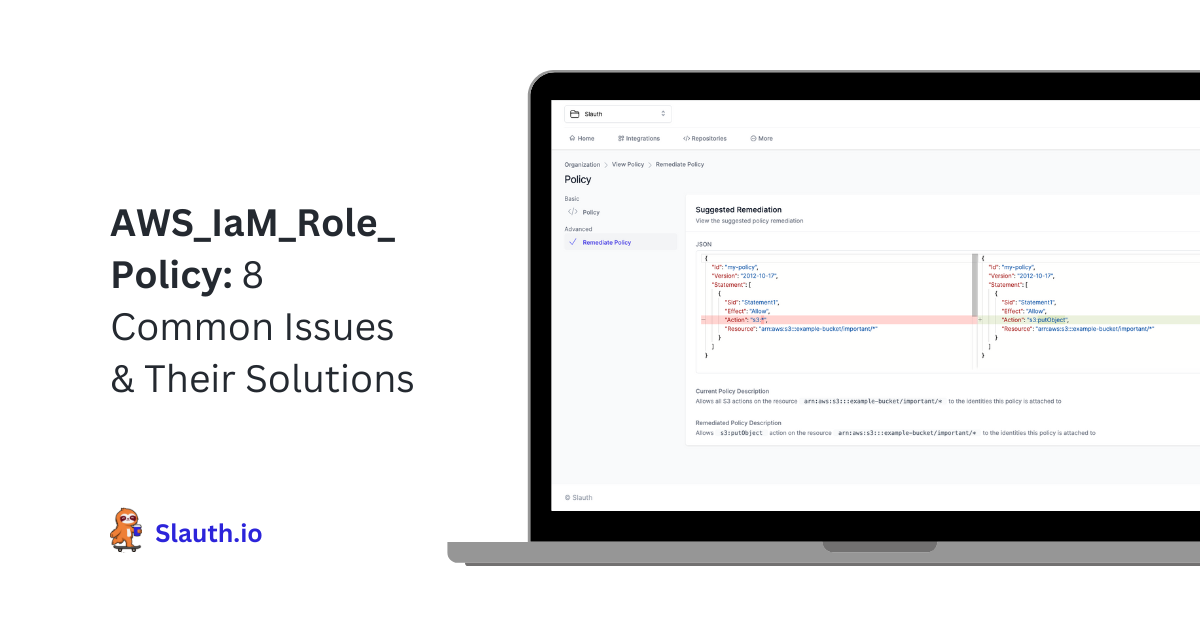AWS_IaM_Role_Policy: 8 Common Issues & Their Solutions
 Eyal Katz
Eyal Katz
Never underestimate the power of your own mistakes, one wise man once must have said. Whether that’s resource mismanagement, insecure APIs, or IAM misconfigurations, most cloud attacks stem from one cause only: human error.
Small security gaps can lead to colossal disasters. Remember how in 2022, nearly 1.5 million files containing sensitive information from at least four airports were publicly exposed because of an unconfigured AWS S3 bucket. Companies could avoid data breaches like this by ticking the AWS ecosystem's basic IAM security checks.
AWS_IaM_Role_Policy is a popular option to ensure you secure resource access by assigning permissions to each account. This article explores AWS IAM Role Policy and its pitfalls that could affect your overall security posture. Before diving into that, let’s understand AWS IAM’s role in securing your cloud ecosystem.
What is AWS_IaM_Role_Policy?
AWS_IaM_Role_Policy is one of the various Identity and Access Management (IAM) tools AWS offers its users. It lets you control what a person (human identity) or an application (machine identity) can do within your AWS account. This person or application is denoted as a principal entity and can be authenticated by assigning them an IAM user or role/function. Then, using this tool, you can set policies for each IAM role and manage their permissions (what kind of resources they can access and the conditions, such as when access is allowed). Do note that you can only assign one policy per role.
AWS IAM Policies
AWS has two types of policies. Identity-based policies are attached to identities like an IAM user, a group, or a role. They state the actions these identities can perform, which resources they access, and under what conditions. They can be managed (used for multiple users, groups, and roles) or inline (used for one specific user or function).
Resource-based policies, on the other hand, let you tag permissions to a resource like an Amazon S3 bucket. They specify what a principal can do with a resource and associated conditions, and they are all are inline. Both types of policies are generally stored in AWS as JSON files.
Defining AWS_IAM_Role_Policy
You can define a policy for the IAM role through Terraform and CloudFormation. Here’s a sample of how you can use AWS_IAM_Role_Policy.
resource "aws_iam_role_policy" "test_policy" {
name = "test_policy"
role = aws_iam_role.test_role.id
# Terraform's "jsonencode" function converts a
# Terraform expression results in valid JSON syntax.
policy = jsonencode({
Version = "2012-10-17"
Statement = [
{
Action = [
"ec2:Describe*",
]
Effect = "Allow"
Resource = "*"
},
]
})
}
resource "aws_iam_role" "test_role" {
name = "test_role"
assume_role_policy = jsonencode({
Version = "2012-10-17"
Statement = [
{
Action = "sts:AssumeRole"
Effect = "Allow"
Sid = ""
Principal = {
Service = "ec2.amazonaws.com"
}
},
]
})
}
The elements of the above function are:
Name – The name of the role policy. It is not mandatory to provide a name. In case you skip it, Terraform will assign a random name.
Name_prefix – It creates a unique name beginning with the specified prefix.
Policy – The inline policy document that is stored in JSON format.
Role – It should specify the function's name for which the policy is attached.
8 Common Issues with AWS_IAM_Role_Policy & Their Solutions
Issue #1: It only applies to a single role
AWS_IAM_Role_Policy enables you to use a policy for just one role. It only allows one-to-one association between the role and the permissions listed in the policy file. You must repeat the process if you want to attach the same permissions to another function. In managed policies, however, you can create the policy once and use it across functions without limitations.
Issue #2: It is a fully manual process
Imagine managing a large ecosystem with hundreds of roles with overlapping policies. You will have to run the aws_iam_role_policy command as many times as there are roles and link them all manually. If you want to change even single permission in a policy, you must rerun the command for every role individually.
Issue #3: It doesn’t help to generate roles
You often need to add new roles dynamically based on specific policies you want to assign. While creating functions based on policies would be convenient, AWS_IAM_Role_Policy cannot generate functions even when they align with the organization's requirements.
A third-party solution like Slauth.io can automate role creation based on policy specifications. The IAM software creates custom IAM roles after thoroughly analyzing permissions and factoring in your unique infrastructure specs while also ticking the Least Privilege box.
Issue #4: It adds complexity and friction
AWS_IAM_Role_Policy adds complexity to managing IAM roles and policies as your organization scales. First, you will have to understand what permissions each function will need, then compile them in policy files, and then assign them to individual functions one by one, manually.
Although you can delegate the policy assignment by creating master admins, who can create, update and delete policies, and limited admins, who can assign policies to roles, creating a web of policy linkages will only increase the friction between functions. Further, if you delete a role, you’re also deleting its attached policy.
Issue #5: It isn’t based on actual activity
AWS_IAM_Role_Policy can assign policies to roles, but it can’t create policies. However, creating policies is a critical challenge. Since the policies don’t consider actual behaviors within your AWS account, they may be inadequate in securing your resources.
To ensure you plug these security gaps, tools like Slauth.io can evaluate your cloud landscape based on real-time behavior analytics and API calls to instances, automatically generating IAM policies that are accurate and secure. Plus, you can save and store IAM behavior to prove compliance with regulations such as SOC, PCI, HIPAA, and GDPR.
Issue #6: It doesn’t provide analytics
AWS_IAM_Role_Policy keeps you in the dark regarding your system as it cannot give you a clear picture of how the policies work for the roles. It doesn’t give you any insights or throw up indications of unusual activities, like a hostile user accessing a role. Without accurate security monitoring and analytics, you live in perpetual fear for your resource security.
Issue #7: Static Policies
If you want to add or modify a policy assigned to a role, it is impossible to do it with AWS_IAM_Role_Policy. This tool doesn’t allow you to update the policies as the needs change. Instead, it demands manual updation of the policies, which could potentially cause inconsistency and create friction within the team. Slauth.io helps you ease setting up and maintaining roles and can identify and update policies based on the newly observed changes.
Issue #8: It can lead to overprivileged accounts
As these are Inline policies, they are hardwired only to be attached to a particular IAM role and are extremely tough to monitor, track and update, leading to overprivileged users. Also, due to the manual and complex process of assigning policies to individual roles, developers tend to assign over-privileges to roles. Although they do this only to save time, it could be a crack for hackers to exploit and breach your system.
Solving the limitations of AWS_IaM_Role_Policy
AWS_IAM_Role_Policy could be a potent tool when you want to be very specific about who you are allowing access to your resources. However, this is a highly manual process and requires you to not only think about which identity should have access to what but manually create the policies for each role. This cumbersome process isn’t very feasible in a busy engineering setting.
Whether dealing with human or machine identities (or both), automation is critical. Ensure the policy creation process is based on actual activity by tracking and understanding past identity behaviors. Then, find a solution that enables you to automate and speed up the policy creation process, closing human error gaps and ensuring the permissions are as accurate as possible (a.k.a, you give identities just enough permissions to perform their tasks without friction).
The work continues once the policies are validated and deployed. Regularly monitor and audit IAM role policies following the principle of least privilege, ensuring the existing roles match your company’s needs, and there are no unused permissions.
Slauth.io’s IAM Policy CoPilot delivers automated policy creation based on tracked activity and least privilege principles. Plus, it provides a 360º view of your identities’ behavior, enabling you to update policies on the go. Join our waiting list to see how easy IAM policy creation and management can be.
Subscribe to my newsletter
Read articles from Eyal Katz directly inside your inbox. Subscribe to the newsletter, and don't miss out.
Written by
